= Euphorbia celastroides var. lorifolia (A.Gray ex H.Mann) Sherff
Bot. Gaz. 97: 597 (1936)
Accepted Scientific Name: Euphorbia celastroides Boiss.
Prodr. [A. P. de Candolle] 15(2): 11 (1862) DC. et al.
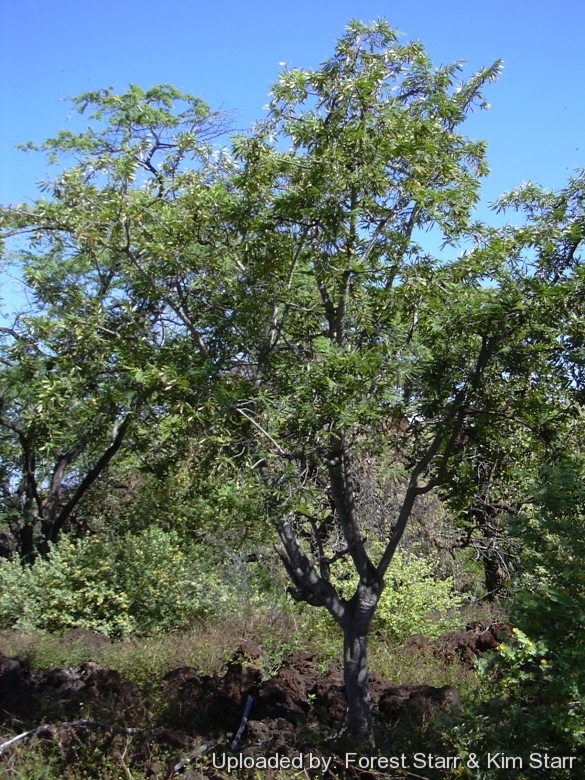
Chamaesyce lorifolia (Euphorbia celastroides var. lorifolia) Photo by: Forest Starr & Kim Starr
Habit at Puu o Kali, Maui, Hawaii (USA). May 26, 2004.
Origin and Habitat: Lānaʻi and Maui island, Hawaii (USA)
Habitat and ecology: Chamaesyce celastroidesSN|28905]]SN|28905]] var. lorifolia is a more tree-like variety found in moister coastal areas, graasy hill tops, and mesic forests on Lānaʻi where it is now rare and on Maui where it is placed in the vulnerable status, but it was one of the dominant components of high elevation dry forest. Though a tree-like species, it is apparently not as tall in height or as wide in diameter as another native tree ʻakoko (Chamaesyce olowaluanaSN|28905]]SN|28967]]). Chamaesyce celastroidesSN|28905]]SN|28905]] var. lorifolia is important for native animal and plant species. Hawaiʻi's only native bees (Hylaeus spp.) use this species as a important food and nesting source. An extinct honeycreeper, the Lānaʻi hookbill (Dysmorodrepanis munroi), searched for small snails among foliage of ōpuhe (Urera glabra) and perhaps Chamaesyce celastroidesSN|28967]]SN|28905]] var. lorifolia. Today, though the vast Chamaesyce celastroidesSN|28905]]SN|28905]] var. lorifolia forests are gone, a few trees still remain on Lānaʻi and Maui, but now a faint reminder of times past. Disturbance caused by grazing, conversion to pastureland and the invasion of alien grasses, increasing the likelihood of serious fires, have all contributed to the decline in the habitat. These rare spurges are in danger of disappearing.
Synonyms:
See all synonyms of Euphorbia celastroides
back
Accepted name in llifle Database:Euphorbia celastroides Boiss.Prodr. [A. P. de Candolle] 15(2): 11 (1862)Synonymy: 49
back
Common Names include:
HAWAIIAN (ʻŌlelo Hawaiʻi): Akoko, Ekoko, Koko, Kokomalei
Description: The Akoko Euphorbia celastroidesSN|28904]]SN|28904]] var. lorifolia , previously also known as Chamaesyce celastroidesSN|28905]]SN|28905]] var. lorifolia is one of the several varieties of the widespread and variableEuphorbia celastroidesSN|28904]]SN|28904]]. It is a small shrub less than 60 cm tall or a small tree up to 5 metres that is easily distinguished by its long thin leaves. The flowers are not attractive. The red or pinkish fruits, however, enhance the beautiful foliage. The varietal name, lorifolia, strap-leaf, in reference to the long leaves of this ʻakoko.
Stems: It forms a loosely branching trunk. The secondary or young branches are stiff, with short internodes.
Leaves: Distichous (growing in two vertical rows), 5 to over 7.5 cm long light or medium green that may have a slight glaucous coating. Often the leaves in the summer assume a red-violet colouring. It does not lose its leaves in the winter, due to the warm climate of its range, but is drought-deciduous. Damaged or old leaves turn a blood red as they die.
Flowers (cyathia): Small, brownish to greenish-white, not showy, a few millimeters in diameter, located in short or open-branched cymes, or ungrouped in leaf axils. Female cyathia have a three-part pistil over a three-part ovary, usually producing three (or sometimes more) seeds. The pungent flowers of ʻakoko have been described as smelling like bad breath.
Fruit: Green or reddish-brown or pink, rounded 2 to 4 mm long. Within each capsule are two or three small seeds.
Phenology: Euphorbia celastroidesSN|28904]]SN|28904]] var. amplectens, produces flower and fruit sporadically throughout the year.
Seeds: Grey-brown seeds 0.5 to 2.5 mm long.
Subspecies, varieties, forms and cultivars of plants belonging to the Euphorbia celastroides group
 Euphorbia celastroides Boiss.: (var. celastroides) Leaves narrowly obovate glabrous (without hairs). Distribution: endemic to Nihoa, Ni`ihau, Kaua`i.
Euphorbia celastroides Boiss.: (var. celastroides) Leaves narrowly obovate glabrous (without hairs). Distribution: endemic to Nihoa, Ni`ihau, Kaua`i. Euphorbia celastroides var. amplectens Sherff: Has pubescent (with hairs) leaves, grey/silverish to light green that may have a glaucous coating. Distribution: is a variable plant found on the uplands on all the main islands (Ni`ihau, Kaua`i, O`ahu, Moloka`i, Lana`i, Maui, Kaho`olawe, Hawai`i.)
Euphorbia celastroides var. amplectens Sherff: Has pubescent (with hairs) leaves, grey/silverish to light green that may have a glaucous coating. Distribution: is a variable plant found on the uplands on all the main islands (Ni`ihau, Kaua`i, O`ahu, Moloka`i, Lana`i, Maui, Kaho`olawe, Hawai`i.)- Euphorbia celastroides var. hanapepensis Sherff: has glabrous, long and oblanceolate leaves. Distribution: endemic to Kaua`i where it grows at high elevations.
- Euphorbia celastroides var. kaenana Sherff: is a glabrous beach plant, with flowers (cyathia) on compact lateral branches. Distribution: endemic to to Kaʻena, Oʻahu. It is a rare and endangered beach plant found among the boulders.
 Euphorbia celastroides var. laehiensis O.Deg., I.Deg. & Sherff: Habit pubescent. Leaves glaucous. Distribution: endemic to Lana`i, Maui near Manawainui. It is found at low elevations and endangered.
Euphorbia celastroides var. laehiensis O.Deg., I.Deg. & Sherff: Habit pubescent. Leaves glaucous. Distribution: endemic to Lana`i, Maui near Manawainui. It is found at low elevations and endangered. Euphorbia celastroides var. lorifolia (A.Gray ex H.Mann) Sherff: is a rare, small and vulnerable tree, with pubescent linear leaves found at high elevations. Distribution: endemic to Lana`i, Maui.
Euphorbia celastroides var. lorifolia (A.Gray ex H.Mann) Sherff: is a rare, small and vulnerable tree, with pubescent linear leaves found at high elevations. Distribution: endemic to Lana`i, Maui.  Euphorbia celastroides var. stokesii (C.N.Forbes) Sherff: is a beach plant, glabrous. Leaves broadly obovate. Distribution: endemic to Ni`ihau, Kaua`i, Moloka`i, Kaho`olawe.
Euphorbia celastroides var. stokesii (C.N.Forbes) Sherff: is a beach plant, glabrous. Leaves broadly obovate. Distribution: endemic to Ni`ihau, Kaua`i, Moloka`i, Kaho`olawe.- Euphorbia celastroides var. tomentella (Boiss.) Oudejans: Tomentose. Distribution: Endemic to Waiʻanae Mts., O`ahu and presumed extinct.
Bibliography: Major references and further lectures
1) Forest & Kim Starr “Euphorbia celastroides (akoko)”. Plants of Hawaii. <http://www.starrenvironmental.com>. Web. 27 Sep. 2014.
2) Wikipedia contributors. "Euphorbia celastroides." Wikipedia, The Free Encyclopedia. Wikipedia, The Free Encyclopedia, 14 May. 2014. Web. 27 Sep. 2014.
3) Wagner, W.; D. Herbst; S. Sohmer “Manual of the flowering plants of Hawaii.” Honolulu: University of Hawaii Press 1990
4) National Museum of Natural History “Flora of the Hawaiian Islands” <http://botany.si.edu/pacificislandbiodiversity/hawaiianflora/> Smithsonian Institution Web. 27 Sep. 20149
5) Andrew W. Mitchell “The Fragile South Pacific: An Ecological Odyssey” University of Texas Press, 1990
6)Geological and Natural History Survey of Minnesota “Reports of the Survey" Geological and Natural History Survey of Minnesota: Botanical series, Volume 2, 1898
7) John L. Culliney, Bruce P. Koebele “A Native Hawaiian Garden: How to Grow and Care for Island Plants” University of Hawaii Press, 1999
8) George C. Munro "The Story of Lānaʻi", pages 64, 67-68, 212-213.
9) Beatrice Krauss "Plants in Hawaiian Culture" by, page 138.
10) J.F. Rock "The Indigenous Trees of the Hawaiian Islands" by , pages 50, 261.
11) William McGeorge & W. A. Anderson "Euphorbia lorifolia, a Possible Source of Rubber and Chicle" by , page 98.
12) H. Douglas Pratt "The Hawaiian Honeycreepers: Drepanidinae" by , pages 130, 217-218.
13) Robert Pearcy & John Troughton "Photosynthesis in Tree Form Euphorbia Species from Hawaiian Rainforest Sites" by , page 1055.
14) A.C. Medeiros, C.F. Davenport & C.G. Chimera "Auwahi: Ethnobotany of a Hawaiian Dryland Forest", page 21.
15) Native Plants Hawaii. “Euphorbia celastroides var. lorifolia” <http://www.nativeplants.hawaii.edu> Web. 27 Sep. 2014.
16) World Conservation Monitoring Centre 1998. Euphorbia celastroides var. lorifolia. The IUCN Red List of Threatened Species. Version 2014.2. <www.iucnredlist.org>. Downloaded on 28 September 2014.
17) CROIZAT, L. AN-D 0. DEGEN;ER. 1938. "Euphorbiaceae" In: 0. Degener, ed., Flora
Hawaiiensis. Privately published.
18) SHERFF, E. E. 1938. "Revision of the Hawaiian species of Euphorbia L." Ann. Mo. Bot. Gard. 25: 1-94.
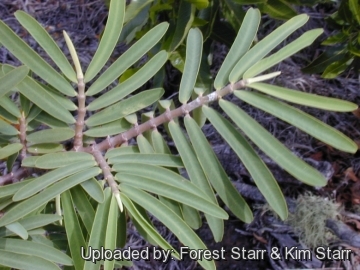 Leaves at Auwahi, Maui, Hawaii (USA). June 22, 2002. (Euphorbia celastroides var. lorifolia) Photo by: Forest Starr & Kim Starr
Leaves at Auwahi, Maui, Hawaii (USA). June 22, 2002. (Euphorbia celastroides var. lorifolia) Photo by: Forest Starr & Kim Starr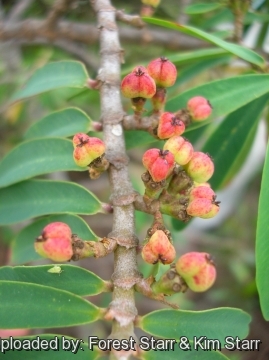 Leaves and fruit at Auwahi, Maui, Hawaii (USA). March 25, 2006. (Euphorbia celastroides var. lorifolia) Photo by: Forest Starr & Kim Starr
Leaves and fruit at Auwahi, Maui, Hawaii (USA). March 25, 2006. (Euphorbia celastroides var. lorifolia) Photo by: Forest Starr & Kim Starr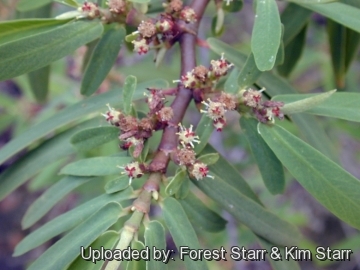 Flowers at Wailea 670, Maui, Hawaii (USA). February 02, 2003. (Euphorbia celastroides var. lorifolia) Photo by: Forest Starr & Kim Starr
Flowers at Wailea 670, Maui, Hawaii (USA). February 02, 2003. (Euphorbia celastroides var. lorifolia) Photo by: Forest Starr & Kim Starr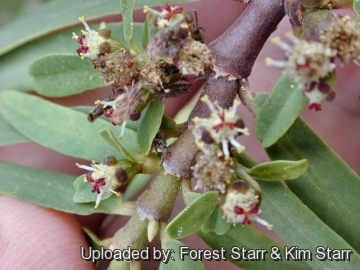 Flowers at Wailea 670, Maui, Hawaii (USA). February 02, 2003. (Euphorbia celastroides var. lorifolia) Photo by: Forest Starr & Kim Starr
Flowers at Wailea 670, Maui, Hawaii (USA). February 02, 2003. (Euphorbia celastroides var. lorifolia) Photo by: Forest Starr & Kim Starr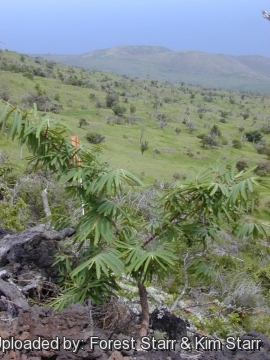 Habit at Auwahi, Maui, Hawaii (USA). June 22, 2002. (Euphorbia celastroides var. lorifolia) Photo by: Forest Starr & Kim Starr
Habit at Auwahi, Maui, Hawaii (USA). June 22, 2002. (Euphorbia celastroides var. lorifolia) Photo by: Forest Starr & Kim Starr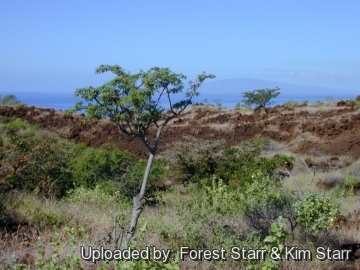 Habit with view Lanai at Puu o Kali, Maui, Hawaii (USA). November 23, 2002. (Euphorbia celastroides var. lorifolia) Photo by: Forest Starr & Kim Starr
Habit with view Lanai at Puu o Kali, Maui, Hawaii (USA). November 23, 2002. (Euphorbia celastroides var. lorifolia) Photo by: Forest Starr & Kim Starr Habit at Ulupalakua Ranch, Maui, Hawaii (USA). June 08, 2012. (Euphorbia celastroides var. lorifolia) Photo by: Forest Starr & Kim Starr
Habit at Ulupalakua Ranch, Maui, Hawaii (USA). June 08, 2012. (Euphorbia celastroides var. lorifolia) Photo by: Forest Starr & Kim Starr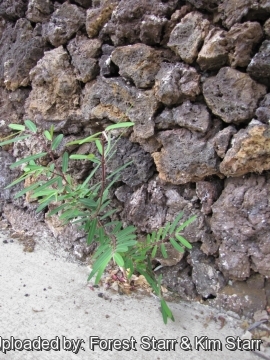 Coming up in concrete crack at Ulupalakua, Maui, Hawaii (USA). June 29, 2011. (Euphorbia celastroides var. lorifolia) Photo by: Forest Starr & Kim Starr
Coming up in concrete crack at Ulupalakua, Maui, Hawaii (USA). June 29, 2011. (Euphorbia celastroides var. lorifolia) Photo by: Forest Starr & Kim StarrCultivation and Propagation: Euphorbia celastroidesSN|28904]]SN|28904]] var. lorifolia or akoko is an attractive tropical species that requires temperatures of 15 °C and light shade. This plant develops in a fashion similar to a shrub or small tree and is tolerant of heat and drought.
Growth rate: They can grow to half a meter a year and flowering and fruiting in optimal conditions.
Potting medium: A gritty, very free-draining compost is suitable, and clay pots help the plants to dry out between watering. Re-pot every 2-3 years.
Fertilization: Akoko respond well to liquid fertilizer (once every one to two months).
Waterings: They like only a short winter's rest and should be kept almost completely dry during the winter months. If the soil is allowed to be dry for too long root loss could follow but equally the same result would occur if the plants are both wet and cold. From March onwards the plant will begin to grow and watering should be increased gradually until late May when the plant should be in full growth. Water regularly during the summer so long as the plant pot is allowed to drain and not sit in a tray of water. During hot weather you may need to water the plants more frequently so long as the plant is actively growing. From late September watering should be reduced to force the plant to go in to a state of semi dormancy, by October you should be back in to the winter watering regime.
Maintenance: This species do tend to get sort of leggy, which is particularly a problem if grown as a potted plant, and pruning is sometime necessary to shape. Repeatedly pruning also help to encourage new growth.
Hardiness: This spurge is tender, hates prolonged cool and is suited for tropical or subtropical climates, it is killed at 0°C or colder for any appreciable length of time, but may survive cold weather even if it end up getting nearly defoliated each winter. (USDA Zones 10a-12b) Any temps below 4° C degrees call for protection for this plant. Seedling growth arrests below 15°C.
Wind hardiness: It is very tolerant and even survives to strong hurricane wind with minimal damages, but will grow better with slow wind.
Salt tolerance: It is tolerant of coastal and beach exposure, as well as salt spray.
Landscape Use: Accent. Hedges.
Hawaiian Uses: The wood of this ʻakoko was used as firewood, the leaves medicinally, and the latex used as an ingredient in canoe paint.
Pest and diseases: They are susceptible to fungal diseases. Wet soil quickly causes root and stem rot, especially during winter months. Pests of akoko include whitefly, and scale insects. The plants also attracts root mealy bug which should be treated with a systemic pesticide or horticultural oil. Often the scale in-sects and mealybugs are brought in and protected by ants.
Propagation: Seeds or cuttings. It is best to collect seed just before or just after the capsules split open to be sure to have fresh but mature seeds. Because of the small size of the seedlings, place little or no cover over the seedbed. Take extra care to avoid letting the seedbed dry out. The seeds will begin sprouting in one to two weeks (sometimes take longer). Let the seedlings grow to about 5 cm in height before separating and transplanting to individual containers. You can also propagateEuphorbia celastroidesSN|28904]]SN|28904]] by stem tip cuttings. Take cuttings about 10 cm in length from actively growing tips with mostly green wood. Rooting time is variable as long as two to three months. After root growth and new stem growth are obvious, transfer the new plant to a standard potting mix.



















